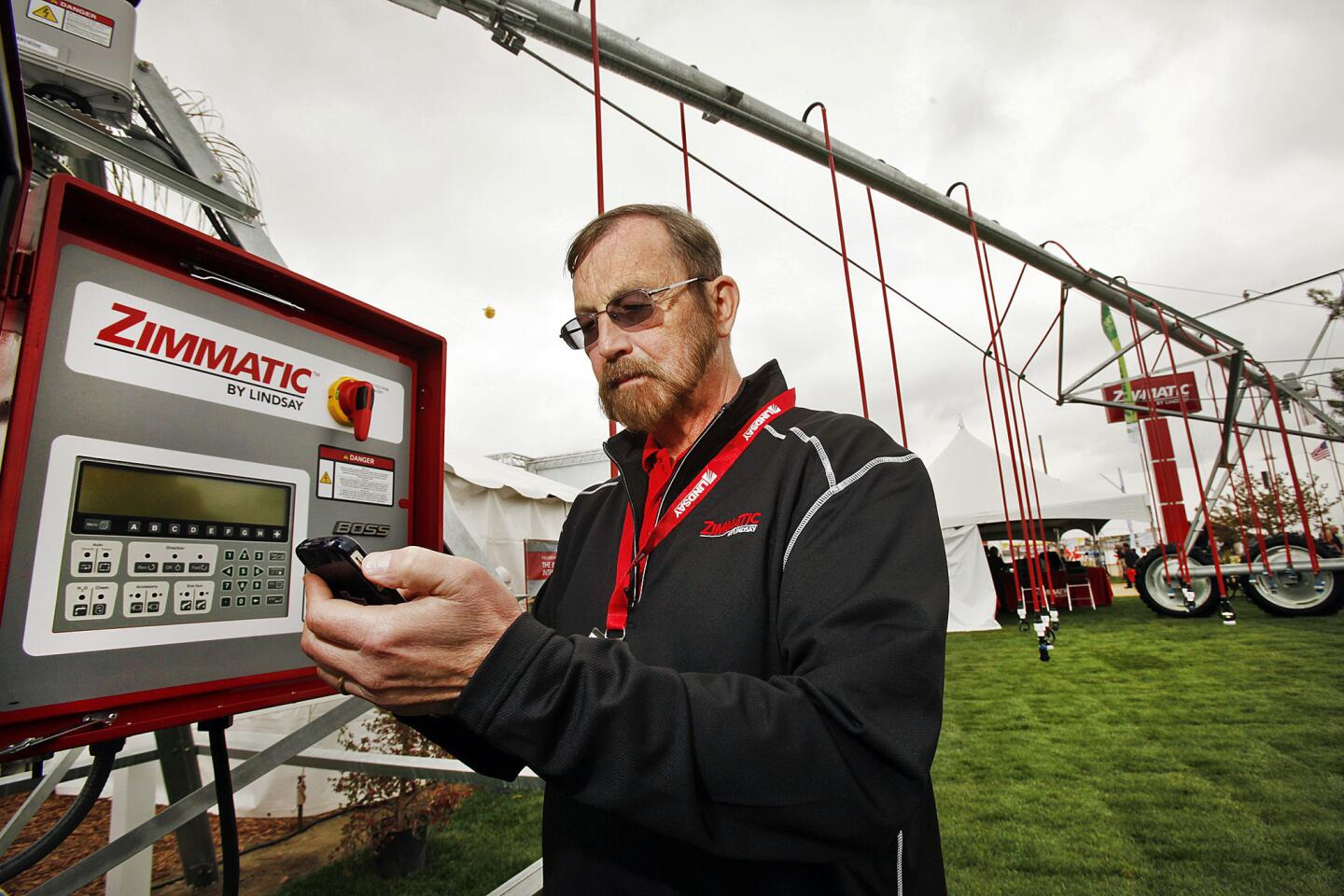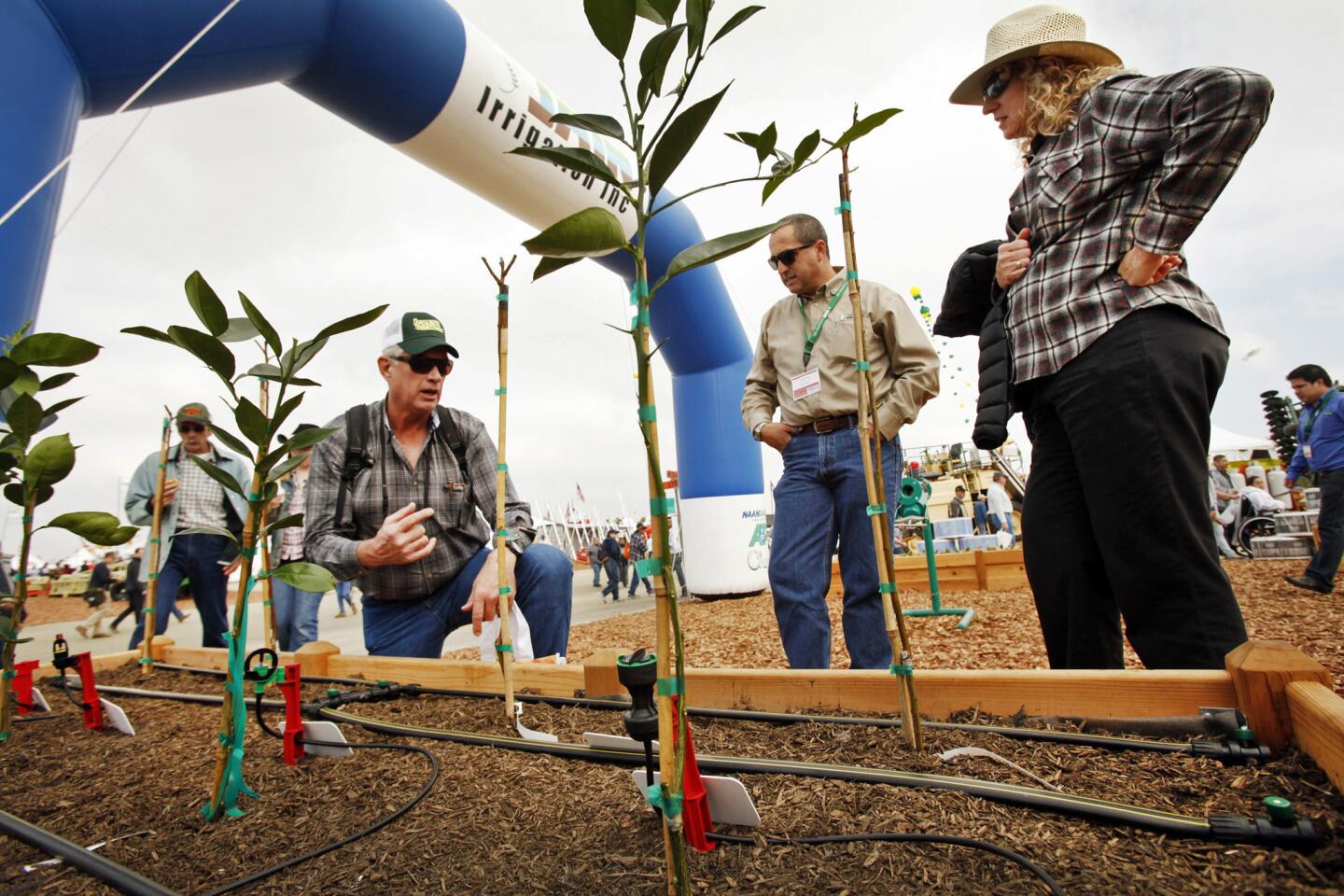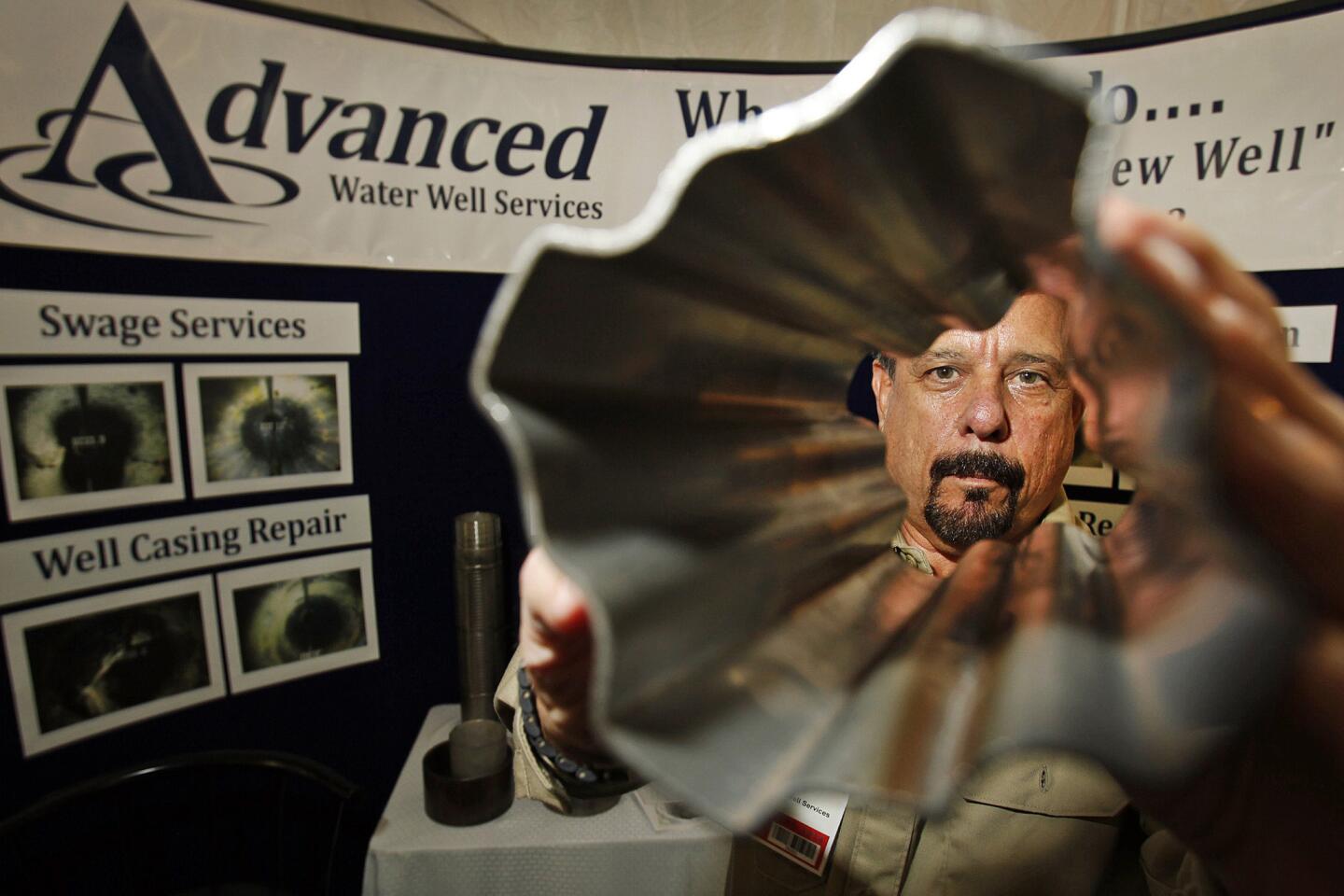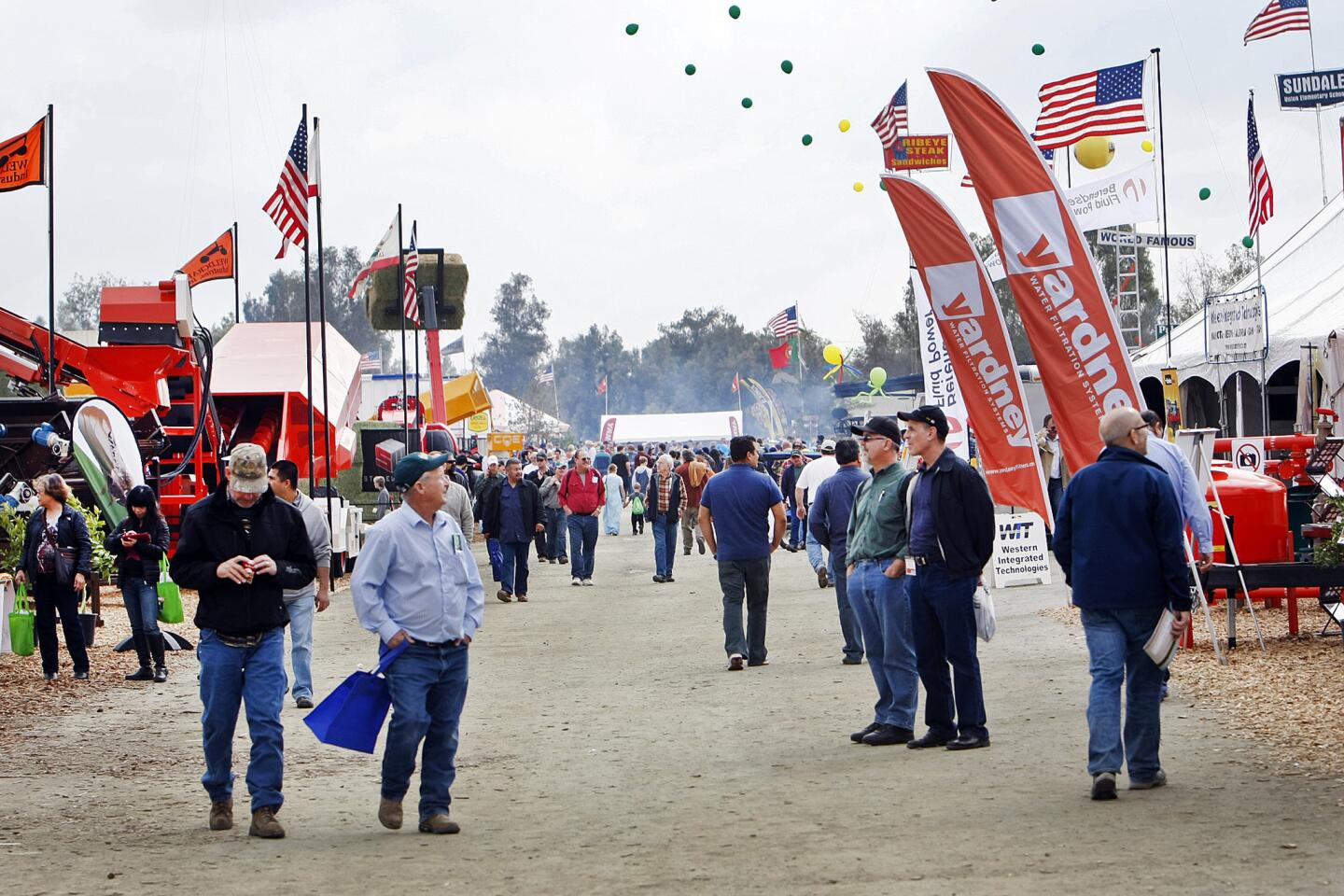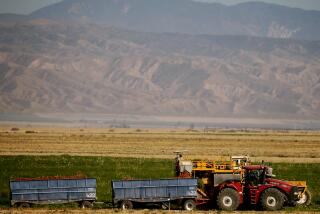Drought brings flood of business for irrigation equipment firms
TULARE, Calif. — California’s drought could prove devastating to the state’s farmers and ranchers. But the dry spell has brought a gusher of new business to companies that provide them with water.
That much was clear at this year’s World Ag Expo, which kicked off Tuesday in Tulare, a town of 60,000 about 45 miles south of Fresno.
At one booth was a well repair company that had to add extra shifts to meet all the agricultural demand for groundwater. Nearby, a firm that provides turbine pumps for wells said orders were coming in so furiously it was running out of parts.
And several feet away, a drip irrigation maker said it was taking orders from farmers months ahead of schedule as the prospect of enough rain over the winter appeared remote.
The World Ag Expo is the largest farm equipment show in the world — a three-day extravaganza of high-tech tractors, automated dairy milkers and mechanized tree harvesters on 2.6 million square feet of fertile Central California soil.
But this year, the annual event is also a window into the frantic struggle taking place to keep the world supplied with fruit, nuts and vegetables from the Golden State.
Amid what could be one of the worst droughts in California’s recorded history, growers are relying on a host of companies to help them deliver what water remains to their fields.
“They’re not just helping farmers adapt, they’re helping them survive,” said Mark Watte, a past president of the expo, which ends Thursday. “There’s going to be a lot of talk here about drought.”
Rain for Rent, a Bakersfield water management firm, has been working in overdrive to mitigate the effects of the dry weather on farmers across California.
Founded in 1934 as an oil field supplier, the company now helps irrigation districts move vast quantities of water to parched areas. It installs new pumps for groundwater wells and lays down temporary irrigation systems on fields that typically get by on rainwater.
Company officials said demand for pumps is so strong that they can’t keep up with orders. And the farmers they rent temporary irrigation systems to are now looking to keep them in place longer than the typical one to three months, they said.
Though business is booming, Rain for Rent is in no mood to celebrate. It knows it’ll suffer too if the customers it relies on go out of business.
“It’s a nasty type of situation,” said Mike Grundvig, a senior engineer for the firm. “We’ve got a six- to eight-week [backlog]. You just can’t respond. None of it is good for business in the long run. It’s not sustainable.”
Workers at Advanced Water Well Services are now servicing customers six days a week rather than the customary five to accommodate demand.
Richard Berry, a representative for the Madera, Calif.-based company at the expo, said some farmers have been scrambling to restore groundwater wells they had long neglected because there was ordinarily sufficient rain.
“A lot of people are turning on pumps for the first time in 20 years and finding they’re not working,” Berry said.
Part of the problem involves cave-ins, cracks in the piping and a phenomenon called subsidence, in which massive groundwater withdrawals are causing the ground to sink in areas of the Central Valley.
Berry’s company is able to thread equipment down a well to patch holes. The service, which includes a new pump, can cost between $20,000 and $30,000.
Berry said that’s more cost-effective than drilling a new well, which can exceed $100,000 — and that’s if you can secure a driller. Waiting lists are said to have stretched to six months in some areas. And as more competition for groundwater forces growers to drill deeper, power companies are being asked to perform upgrades to deliver more energy to operate stronger pumps. That, too, has a long waiting list.
“It’s just a mess,” Berry said. “Sometimes a farmer will need a loan to fix their well but the banks won’t lend to a farmer with no water.”
With water looking ever more precious, more growers are turning to efficient irrigation practices to minimize waste and boost yields.
California’s $45-billion agricultural sector consumes 80% of the state’s water supply. An educational exhibit for children at the expo grounds drilled home that point with a plush cheeseburger toy. Stitched onto each ingredient was the amount of water it required to grow — from 1.5 gallons for the piece of lettuce to 616 gallons for the beef patty.
The need to use available water more efficiently has driven interest in the drip-tape irrigation on display at a booth run by Toro, an outdoor maintenance company whose micro irrigation division is based in El Cajon, Calif.
Claude Corcos, a marketing manager, said California leads the nation in drip and micro irrigation, which includes tubes with small incisions that deliver predetermined amounts of water directly to crops when they need it.
Tomato growers embraced the technology years ago because they could bury the tubes under the soil. The vines soaked up the water, keeping the fruit plump, while the ground remained dry enough for mechanical harvesters.
“You get higher yields, better quality and water efficiency,” Corcos said.
California still has much room to improve, said Claire O’Connor, policy analyst for the New York-based Natural Resources Defense Council.
The most recent Census data show more than half of the state’s 7.3 million irrigated acres rely on water-intensive flood irrigation, which uses 35% more water than basic sprinkler irrigation. Among other major agricultural states, Nebraska relies on flood irrigation for 20% of its irrigated land, Texas about 19% and Kansas only 7%.
“We don’t know whether this drought will last one year or multiple years, but we can be pretty sure it’s not the last dry period California farmers will face,” O’Connor said. “They should be thinking long term about what kinds of investments into irrigation infrastructure they’ll need so it won’t be so rough the next time around.”
O’Connor said many irrigation districts also need to consider upgrading infrastructure because they can influence what types of irrigation farmers use.
Tape irrigation works best when farmers have access to small amounts of water at a time to slowly drip. But some districts can’t do that because they deliver predetermined water allowances on a fixed schedule, she said.
Watte, the expo’s former president and a Tulare farmer, is dubious and believes the state’s agriculture industry has already made great improvements in water efficiency.
“All the low-hanging fruit is gone,” he said. “At the end of the day, there’s just not a lot of water to divvy up.”
More to Read
Inside the business of entertainment
The Wide Shot brings you news, analysis and insights on everything from streaming wars to production — and what it all means for the future.
You may occasionally receive promotional content from the Los Angeles Times.
